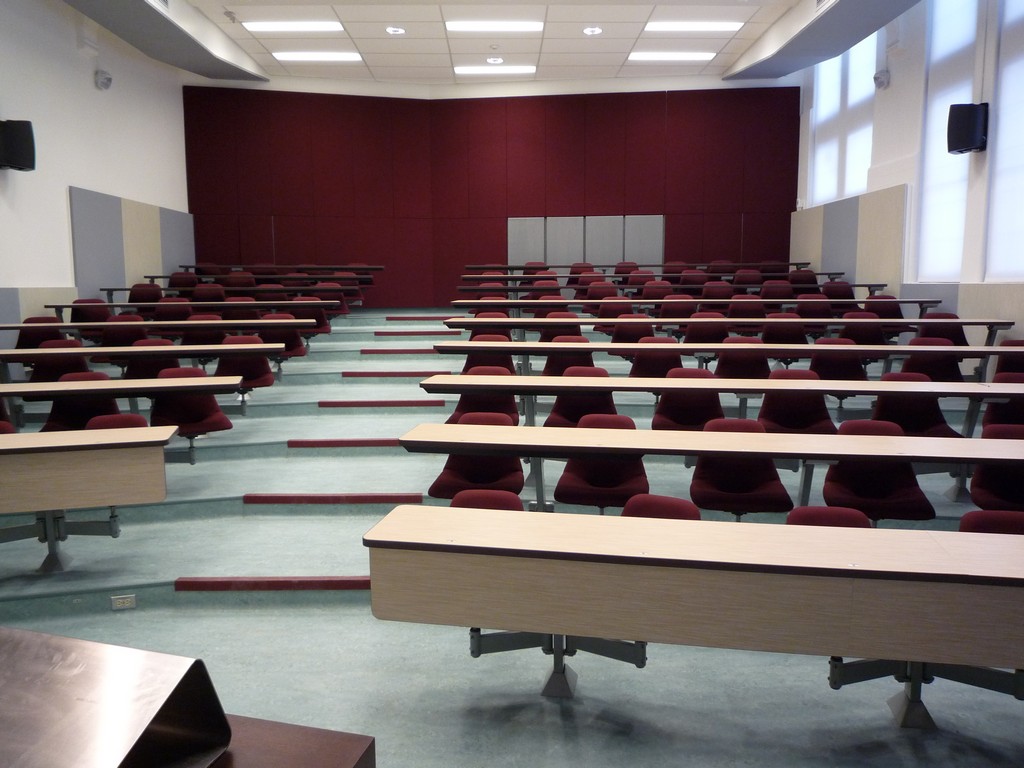- Location: 3640 University St., Montreal, QC
- Capacity: 94 students
- Type: Active learning lab
Alignment with principles for designing Teaching and Learning Spaces
Academic challenge
Promote individual, active engagement with content.
Layout
Students can work individually, in pairs or in teams of up to six people, at triangular tables. Each table has ample work surfaces for laboratory work or for classroom materials (e.g., notebooks, laptops, and textbooks).
Furniture
Adjustable-height stools on wheels for optimal comfort.
Technologies
Access to infrastructure: power for student laptops, networked printing. Access to resources: LMS, internet. Multiple sources (Sympodium, two document cameras, including one for geology lab work) and screens for simultaneous display of different learning materials.
Lighting & colour
Appropriate overhead lighting permits individual work during or outside of laboratory and class sessions. Large windows and tall ceilings create a spacious environment with ample natural light.

Learning with peers
Promote active engagement with one another.
Layout
A layout with 8 large triangular tables permits students to move easily from small group to larger group portions of class work: students at each table can work together as a large group of 6, or in smaller groups of 2 or 3. Students are able to easily circulate in the classroom due to sufficient passing space between tables.
Acoustics: Sound zones by table support multiple simultaneous conversations among students.
Furniture
The table layout permits collaborative approaches to coursework and improved communication (both verbally and line-of-sight). The standing-height tables support student movement as experiments are set up and conducted, while stools on wheels permit students to easily move their attention from small-group to larger-group activities. Acoustics: Sound zones support multiple simultaneous conversations among students.
Technologies
Shared workspaces include a whiteboard for each table. Power outlets at each table allow students to keep their computers charged during class.
Lighting & colour
Table centers are colour-coded for ease of reference.
Experiences with faculty
Promote interaction and communication.
Layout
Instructor’s podium is located towards the centre of the room and has plenty of space for all equipment and for the instructor’s materials. A second small, mobile podium allows the instructor to move around the room with even greater flexibility. The instructor has access to all students due to a layout that permits ample passing space, and clear sightlines. A partial partition permits the preparation of lab materials for the next course without distracting the students and instructor.
Acoustics: Sound zones ensure that not only are students able to hear the instructor, but that the instructor is also able to hear the students. Instructor has a wireless and a wired microphone available.
Furniture
Tables are easily accessible and have sufficient space surrounding them for the instructor to check in with a given group. Standing-height tables and adjustable-height lab stools reduce hierarchy between instructor and students.
Technologies
Multiple projecting surfaces around the classroom permit display of different learning materials at the same time (e.g., from the document cameras, instructor’s computer, tablet/sympodium).
Lighting & colour
Lighting patterns provide a bright, pleasant environment and support multiple types of teaching and learning tasks.
Contributions to the campus environment
Active learning labs (flexible spaces that incorporate elements of active and collaborative learning) are part of a vision for campus learning spaces of many different sizes. This learning space can function both as a geology lab and as a classroom, to maximize space use. Both physical and virtual affordances help maximize High Impact Practices (HIPs) for student learning within and beyond this teaching lab.
